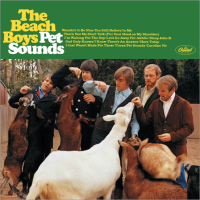February 10, 2014 Pet Sounds
This is a slightly-edited repost of an article from 2006 on another blog of mine. A mixture of not knowing what to post and a feeling that it did not get as much traction back then as it should have is what prompts its repost here today.
A few weeks back I bought the Beach Boys album Pet Sounds. I have always liked The Beach Boys, but I only owned a couple of compilation albums that had all of their most popular songs. I had always heard that Pet Sounds was “groundbreaking” and a “must have,” so I finally bought it.
I had heard four of the thirteen songs on the album before, but the rest were new to me. To my untrained ear, it sounded like, well, The Beach Boys. So what was so groundbreaking? After all, I had heard that after The Beatles heard this album they freaked out, along the lines of “Brian Wilson is so far ahead of us!” and “We better catch up!” (Their answer was Sgt. Pepper’s Lonely Hearts Club Band, an album widely acknowledged as an album that changed the face of pop music forever.)
I asked Dave why Pet Sounds was so groundbreaking, as he is widely considered the “go-to guy” for all things Beach Boys, at least in my circle of friends. He really is quite knowledgeable on this subject, so I post his response in its entirety (though edited for various things such as non-capitalized letters and such). I realize this will be interesting to exactly .02% of you reading this, but I felt his breakdown was … breakdown-y enough that other people ought to be able to read it.
It is ground breaking in that it turned pop song form inside out and then tore it up and then taped it back together again. The structure of “You Still Believe in Me,” “Don’t Talk,” and “That’s Not Me” were very bold compared to the standard verse chorus verse chorus bridge (maybe a third verse) chorus. Even songs like “God Only Knows” which was fairly traditional in construction were ground breaking in chord progressions, modulations within the verse and chorus that required another modulation to get back to the original key for the start of the second verse.
Also all of the instrumentation and orchestration was pretty unusual. Most songs have 2 or three basses (2 different electric basses and one acoustic) to give the bass line a really fat sound. Throughout you will hear such exotic (at the time) instruments as the bass harmonica (“I Know There’s an Answer”), accordion (“Wouldn’t It Be Nice”), flute (“God Only Knows”), all manner of other wind instruments (listen for the oboe that doubles the vocal melody on the verses of “I’m Waiting For the Day”) and strings (the surprise slow down at the end of that same “I’m Waiting” as well as all of “Don’t Talk”). Also the intro to “You Still Believe in Me,” is Brian [Wilson] plucking the piano strings of a piano prepared with little washers and stuff on the strings to give it a funny jangly sound. The weird guitar solo in the middle of “Let’s Go Away for a While” was made by using a coke bottle on the guitar strings. These are just a few examples of the kind of innovation and experimentation that the album is chock full of.
Then there is the percussion. Brian had been eschewing the simple backbeat played on the normal drumset and cymbals for a few albums now (check out the original version of “Let Him Run Wild”). The best examples of his spare but dramatic use of percussion are found in “Don’t Talk” (in which the bass provides most of the “beat” and also contains timpani), the tambourine featured throughout “I Know There’s an Answer,” the carefully placed and fairly raucus (for a relatively contemplative song) drums in “That’s Not Me.” The exotic sounding “drums” at the beginning of “Caroline No” (that alternate with the tambourine) are actually orange juice bottles filled with water to achieve the exact sound Brian wanted. Then of course there is “Pet Sounds” which is a percussionist extravaganza.
Also the subject matter was very advanced for the time. Consider what songs topped the charts the same year as “Wouldn’t It Be Nice” (a song about yearning for the day when they could spend the night together) and “God Only Knows” broke into the top 40:
“We Can Work It Out” (Beatles)
“Wild Thing” (Troggs)
“Counting Flowers on the Wall” (Statler Brothers)
“You Can’t Hurry Love” (Supremes)
“Good Lovin’” (Young Rascals)
“Ballad of the Green Beret” (Sgt. Barry Sadler)
“Barbara Ann” (Beach Boys)Lyrics like “I once had a dream so I packed up and split for the city/I soon found out that my lonely life wasn’t so pretty” strike a sharp contrast to the relatively fun, straightforward approach those other songs took.
Finally there was the depth of the production which in part was based in everything above. You will hear this especially in the stereo version of “Wouldn’t It Be Nice.” Ignore the words and listen to just the instruments. No one else sounded this . . . full and wide open at the time, with the possible exception of Phil Spector productions. I could go on. I have probably said more than you care to read anyway. Enjoy.
On top of all that, the album is enjoyable to listen to. Many “concept albums” are a chore to listen to, as you feel like you ought to be getting something more out of them, but this album still succeeds as listenable.
Tags: Beach Boys
Written by: Mark
- Leave a comment
- Posted under Music

Leave a Reply